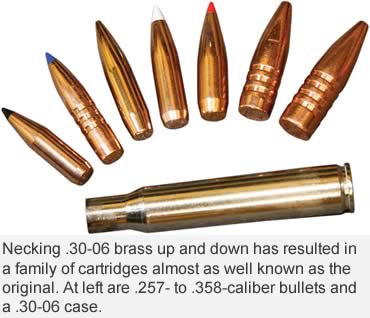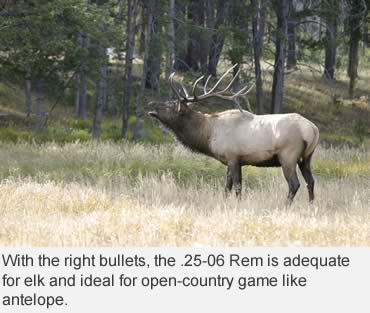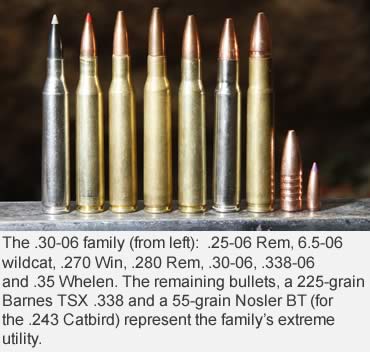Offspring of the .30-06 are popular and effective, just like their Ma.
Most hunters know that the .30-06 Springfield, now 105 years old, has proven to be one of the most versatile hunting cartridges in the world. It’s been used to take everything from elfin squirrels to enormous elephants.
Many hunters might not know that the .30-06 has also reproduced. That’s right. The mother cartridge has spawned a nice little family of other famous cartridges. You’ve probably shot some. You may own some and not even realize it.
The .30-06 was created in response to the amazing and deadly performance of the German 7x57mm Mauser used by Spanish soldiers in Cuba during the Spanish-American War of 1898. This was one of the first military cartridges to use smokeless power to propel a spire-point bullet at high velocity. It flew flat enough to prove deadly when Teddy Roosevelt and his Rough Riders were attempting to take San Juan Hill in Cuba.
 While the U.S. forces with their slower blackpowder-powered .30 Krag rifles were ultimately successful, it was obvious that America needed to upgrade its firepower. The .30-06 was developed at the Springfield Armory and adopted in 1906. Just three years later, Roosevelt was hunting with a sporterized .30-06 Springfield in Africa, and that set the stage for its quick rise to prominence.
While the U.S. forces with their slower blackpowder-powered .30 Krag rifles were ultimately successful, it was obvious that America needed to upgrade its firepower. The .30-06 was developed at the Springfield Armory and adopted in 1906. Just three years later, Roosevelt was hunting with a sporterized .30-06 Springfield in Africa, and that set the stage for its quick rise to prominence.
The cartridge’s ballistics is what truly continues to make it famous. It will fire bullets from 100 grains to 220 grains at velocities from 3,400 fps to 2,500 fps, respectively. This makes it suitable for everything, though perhaps ideal for nothing as critics claim. One doubts any animals shot with it would concur. Recoil from a .30-06 firing a 180-grain bullet from an 8-pound rifle is generally considered all the average hunter can easily tolerate for sustained shooting.
The desire to make the .30-06 something better than the all-round cartridge it is has long inspired wildcatters to enlarge and reduce its neck. This has resulted in a family of cartridges nearly as well known as the original. Of these, the most successful is the .270 Winchester introduced in 1925.
While essentially nothing more than .30-06 brass necked down to take a .277-inch bullet, the .270 is slightly longer to prevent it from being inserted into a .30-06 chamber.
With a 130-grain bullet, the .270 shoots about 100 fps faster and subsequently flatter than the .30-06 pushing a 150-grain slug, making it popular in open-country hunting for mule deer, pronghorns and sheep. With a 150-grain bullet, the .270 has proven deadly on elk, moose and even the biggest bears, and 90- to 100-grain bullets at 3,600 and 3,400 fps make it an effective, comfortable-to-shoot varmint round.
The .257 version of the .30-06, now known as the .25-06 Remington, actually pre-dates the .270. In 1920, it was introduced as the .25 Niedner wildcat to outperform the .250 Savage and another wildcat, the .257 Roberts. Remington didn’t legitimize it as a factory round until 1969. The cartridge was initially presented as a super-fast, long-range varmint tool throwing bullets as light as 75 grains as fast as 3,700 fps.
Heavier 100-grain pills at 3,300 fps and 120-grain slugs at 3,000 fps make it ideal for open-country game. Premium controlled-expansion bullets in the higher weights made the .25-06 adequate for elk, but it is ideal as a pronghorn/mule deer/coyote rifle. The only faster commercial quarter-bore is the .257 Weatherby Magnum.
 There is so little difference between a .277 and .284 bullet that many wouldn’t bother, but Remington necked down the .30-06 to make the .280 Remington in 1957. From the start, it had trouble competing with the established .270 Winchester, even though it can be argued .284 bullets make the .280 Rem slightly deadlier on larger game.
There is so little difference between a .277 and .284 bullet that many wouldn’t bother, but Remington necked down the .30-06 to make the .280 Remington in 1957. From the start, it had trouble competing with the established .270 Winchester, even though it can be argued .284 bullets make the .280 Rem slightly deadlier on larger game.
Remington’s release of the 7mm Rem Mag in 1962 didn’t help .280 sales, so in 1979 Remington reintroduced it as the 7mm-06, then changed the name a few months later to 7mm Remington Express. That sounded too much like the 7mm Rem Mag, so a few years later, Remington went back to the original .280 Rem. Despite the name confusion, it remains an excellent all-round big game cartridge performing a smidgen better than the .270 Win and within 100 to 200 fps of its magnum cousin.
Necking up the .30-06 to accept a .357 bullet in 1922 resulted in the superb .35 Whelen. Despite devastating punch and reasonable recoil suitable for any game in North America and most in Africa, the .35 Whelen didn’t reach commercial status until 1988, when Remington finally released it. They wisely kept the original wildcat name.
Fans of this .35 claim it hits like a .375 H&H with less recoil. Trajectory is flat enough for a Maximum Point-Blank Range of 325 yards with a 10-inch target. It’s easily flat enough for big game trajectories to 300 yards.
Even less popular than the .35 Whelen is the .338-06. This was another wildcat with an interesting past. First loaded with .333 bullets by Elmer Keith and friends and labeled the .333 OKH in 1945, the round suffered from a paucity of .333 bullets.
 None were made in the U.S. But when Winchester released its .338 Win Mag in 1959, folks expanded their .30-06 brass to fit the slightly wider bullets, rebarreled their rifles and enjoyed shooting 200- to 250-grain .338 bullets 2,800 to 2,550 fps, making this another superb, reasonably mild-recoiling cartridge for big deer, bears, elk and moose.
None were made in the U.S. But when Winchester released its .338 Win Mag in 1959, folks expanded their .30-06 brass to fit the slightly wider bullets, rebarreled their rifles and enjoyed shooting 200- to 250-grain .338 bullets 2,800 to 2,550 fps, making this another superb, reasonably mild-recoiling cartridge for big deer, bears, elk and moose.
With the .338 Win Mag to compete against on one end and the .30-06 on the other, the .338-06 never drew a huge crowd. Nonetheless, the A-Square company legitimized it in 1998, and Weatherby started chambering rifles for it three years later. This is another excellent but overlooked child of the .30-06.
Wildcatters have necked the ’06 case to just about every other bullet diameter possible, but none have achieved status as a factory round. A .243 version by Kenny Jarrett is called the .243 Catbird. It hits 4,100 fps with a 70-grain bullet.
The .280 Ackley Improved is based on the .280 Remington case with the shoulder angle changed to 40 degrees and the wall taper reduced. This increases powder capacity sufficiently to add about 100 fps to .280 Rem loads. More importantly for handloaders, it minimizes the need to trim case necks, extending case life. Nosler recently legitimized the .280 AI as a factory round and began chambering its Model 48 rifle for it.
The 6.5-06 wildcat is so popular that many reloading manuals list recipes for it. At least two blown-out versions — meaning the walls are straightened and shoulder is pushed forward — are fairly popular. The 6.5 Gibbs reportedly reaches 3,325 fps with a 120-grain bullet, and the 6.5-06 Ackley Improved hits 3,100 fps.
Descendents of the .30-06 are numerous because so many rifles are available in .30-06 action lengths. Rebarreling and rechambering while maintaining the original head diameter and overall cartridge length makes things easy.
The powder volume of the case is a nice balance, giving good to excellent velocity and energy without excessive noise, recoil and powder consumption. The .30-06 and its extended family should hang around for at least another 100 years.
Read Recent GunHunter Articles:
• Marlin’s XT Youth .22s: The XT series of rimfire rifles are budget models with kid-worthy features.
• Shotgun Choke Designations: Other factors besides choke constriction influence pattern size, and only through testing can you learn how a load performs in your gun.
This article first appeared in the August 2011 issue of Buckmasters GunHunter Magazine. Subscribe today to have GunHunter delivered to your home.